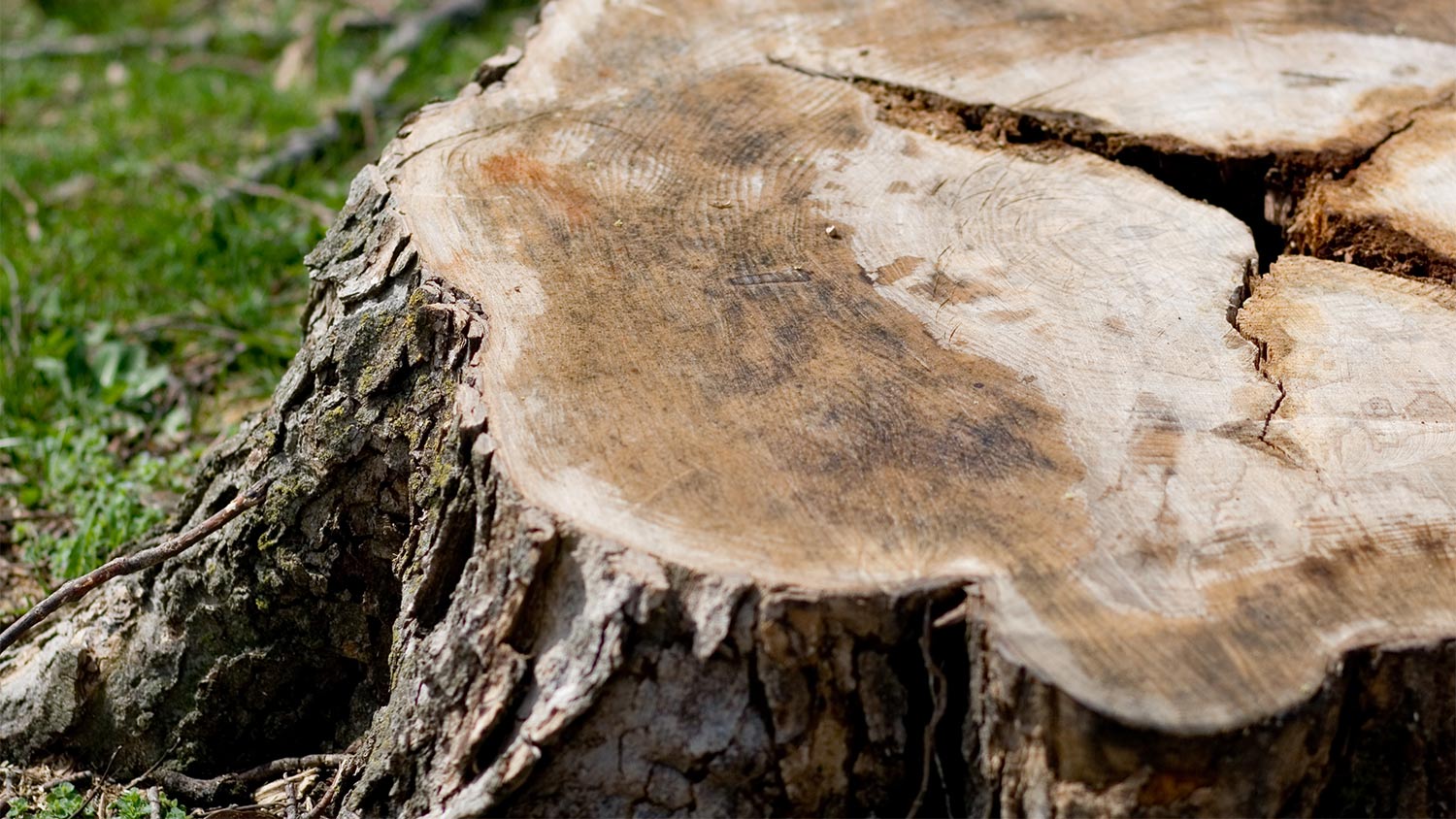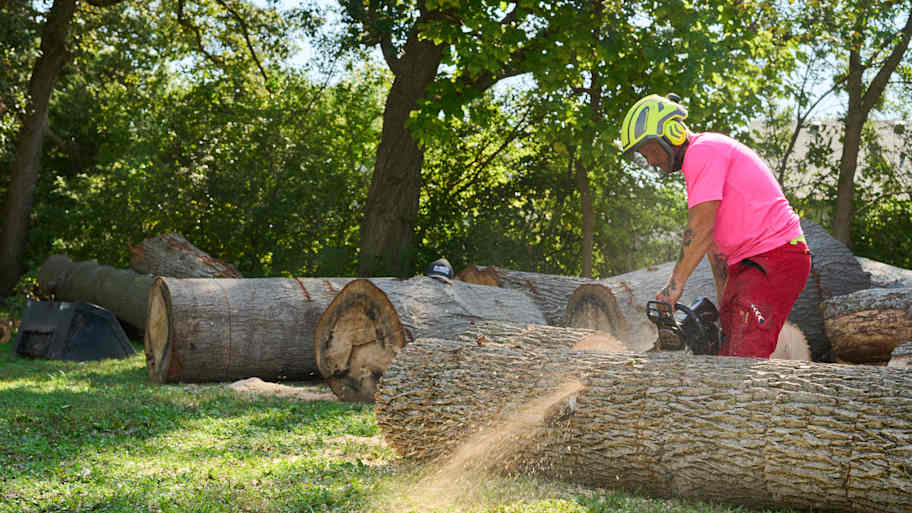
The most significant factor in tree removal costs is the amount of debris. Read on to learn more about the average tree debris removal costs.
Save time, money, and your back by rotting a tree stump


Unfortunately, a stubborn tree stump can linger for years or even decades. Instead of waiting it out or using a stump grinding service, learn how to rot a tree stump fast using the right chemicals and a few proven methods to speed up that stump’s demise. Find out how to rot a tree stump quickly and easily.

Complex, high-risk projects demand more than typical DIY projects. They require time, specialized tools, and trained expertise to make sure the job is done safely and correctly. We made it easy for you to find a local pro—with our skilled network, you'll get the job done without the stress of doing it yourself or significant safety risks.
If you're looking for a chemical-free and pet-safe option, boiling water is one of the simplest methods to kill a tree stump. It won’t work overnight, but with patience and repeated applications, it can be an effective way to halt stump growth and kickstart the decomposition process.
To use boiling water:
Drill deep holes into the top of the stump to help the water reach the roots.
Carefully pour boiling water directly into the holes while wearing protective gloves and long sleeves.
Repeat the process several times over the course of a few weeks.
Keep the stump covered with a tarp between applications to retain heat and moisture.
Mulch over the tarp to help hold it in place and encourage decay.
Drilling holes is a key prep step in many stump-killing methods, but you can also use it to speed up natural decomposition. By increasing airflow and moisture absorption, drilling holes allows fungi and bacteria to break down the wood faster over time.
To use this method:
Drill holes at least 8 to 12 inches deep into the top and sides of the stump.
Space them a few inches apart across the entire surface area.
Soak the holes with water to promote fungal growth.
Cover the stump with a tarp to keep it dark and moist.
Apply mulch over the tarp to insulate and accelerate decay.

Using commercial stump removal products will rot a tree stump fast. These products feature strong chemical agents that break down wood fibers quickly. While they are very effective, they can pose environmental risks, so always use them cautiously and carefully follow instructions on the label.
To use chemical stump removers:
Drill holes into the stump to allow for deep penetration of the chemical.
Pour the stump remover into the holes, then add water as directed to activate the product.
Avoid oversaturating to prevent harmful runoff into the surrounding soil.
Cover the treated stump with a tarp to keep it moist and shielded from the sun.
Add mulch on top of the tarp to lock in heat and moisture for faster results.
One of the most effective methods is potassium nitrate pellets, which is the active ingredient in many stump-killing products. Be aware that potassium nitrate is a danger to pets and wildlife, so use it sparingly to minimize run-off into the surrounding soil.
To use potassium nitrate pellets:
Drill holes in the stump.
Add the pellets to the drilled holes, and then apply water. The potassium nitrate will soak into the tree’s living tissue, killing it and promoting decomposition.
Soak the stump with water so that the pellets dissolve and disperse.
Cover the stump with a tarp to keep it dark and moist.
Mulch around the stump on top of the tarp to keep it in place.
We normally associate fertilizer with something you apply to help plants grow, but it also does a pretty good job of killing tree stumps. That’s because many garden fertilizers are loaded with nitrogen, the key ingredient to speeding the demise of a tree stump.
To use fertilizer:
Drill holes in the stump.
Apply it to the holes you drilled in the stump, just like potassium nitrate pellets. Pile mulch over the holes, then apply water to activate the fertilizer’s stump-killing powers.
Soak the stump with water so that the fertilizers spread but don’t over-fertilize your garden.
Cover the stump with a tarp to block out sunlight and make sure the stump doesn’t keep growing.
Mulch around it to make sure the tarp doesn’t move.
Most of the stump killers available at your local home improvement store use one of these two active ingredients. While they are one of the most effective ways to kill tree stumps, they also present the greatest environmental risk, especially if these chemicals find their way into groundwater and waterways.
Luckily, you don’t need to saturate the trunk for it to be effective. Most products containing these chemicals use a squeeze bottle design that makes it easy to treat the stump while minimizing run-off.
To use triclopyr or picloram:
Put on rubber gloves, as these chemicals can cause skin irritation.
Apply triclopyr or picloram just inside the bark around the entire circumference of the stump for the best results.
Soak the stump with water after you apply the chemicals.
Cover the stump with a tarp.
Mulch around the top of the tarp to hold it in place.
If you can't guarantee that you’ll keep pets and children away from the stump, you can use yeast nutrient, a food-grade urea beer makers use during the fermentation process when brewing beer. It isn’t as effective as potassium nitrate, but it will still get the job done. You can find yeast nutrients online or in stores that specialize in homebrewing.
To use yeast:
Drill holes in the stump.
Pour the yeast into the holes and reapply as necessary.
Soak the stump with water after putting in the yeast.
Cover the stump with a tarp to block out sunlight.
Make sure the tarp is secured with mulch to keep it in place.
This popular bathwater additive that does wonders for aching muscles also happens to be an effective means of killing a tree stump. The same magnesium and sulfate that relaxes muscles and reduces swelling also pulls moisture out of tree tissue, drying out the remaining trunk and the roots. Better yet. Epsom salt is safe to use around people, won’t harm the environment, and has the added benefit of nourishing the soil for future plantings.
To use Epsom salt:
Drill holes in the stump.
Fill the holes with Epsom salt.
Soak the stump and the holes with water.
Cover the stump with a tarp to hold the salt and moisture in.
Mulch around the stump and over the tarp to keep it in place while the stump is decomposing.
No matter which of these measures you take to rot a tree stump, it will take time. You should begin noticing results within six to eight weeks, but it will take months for the stump to decompose.
Be patient and take heart in the knowledge that you're shortening a natural process that takes years into months. You’ll also be saving your back from manual removal and your wallet from the cost of professional stump grinding.
If you absolutely must have that offending stump gone yesterday, then you’ll need to hire a professional stump removal service near you to grind it out.
The cost of stump grinding is between $170 and $500, depending on where you live and the stump's size. Since much of that cost is associated with hauling the grinder out to your house and onto your property, it’s more affordable to have multiple stumps taken out at once than it is to hire a company to come out for individual stump removals.
If you're planning on removing multiple trees over a period of months, wait until you’ve taken all the trees down, then hire a professional to come out and remove all the stumps at once to save money.
There are many potent household chemicals already sitting in your garage or cupboard that can technically bump off a tree stump—bleach, gasoline and trisodium phosphate (TSP), to name a few—but you’ll be barking up the wrong tree if you use them.
Covering a stump in bleach, TSP, gas and other toxic chemicals will certainly kill it, but it will also take out just about everything else it comes into contact with and render the soil toxic for future plantings. More importantly, these chemicals pose enough of a threat to the larger environment that using them for this purpose is simply irresponsible.
Simply put: Don’t try to use these methods alone and especially not mixed together. Try one of the suggestions below instead.
While there’s more than one way to kill a tree stump, there are several reasons to pick stump rotting as your weapon of choice. First, stump rotting using the methods below accelerates the decomposition process from the years it would take to rot away naturally to mere months.
It’s also more affordable and safer than other stump removal options. Though it takes much longer to rot a stump than it does to hire a professional to grind it out, you’ll save hundreds of dollars.
Rotting out a tree stump also requires very little physical effort, especially when compared to the backbreaking alternative of physically removing a tree stump.
From average costs to expert advice, get all the answers you need to get your job done.

The most significant factor in tree removal costs is the amount of debris. Read on to learn more about the average tree debris removal costs.

How much does a palm tree cost? The answer depends on the type of tree, its size, and other factors. Find out how much a new palm tree costs.

The cost to remove palm trees depends on several factors, including their size, location, and more. Our guide shows the average palm tree removal costs.

Follow these tips to learn how to find a good tree removal service. Doing a little research can help you save time and money when you need to say goodbye to your trees.

If you’ve hired a tree service to trim your trees or remove them, you’ll have to decide whether to tip the pros afterward. Learn more about your options.

Tree felling requires strategic cuts to make the tree land accurately. Check out the types of tree felling cuts and notches used for various conditions.